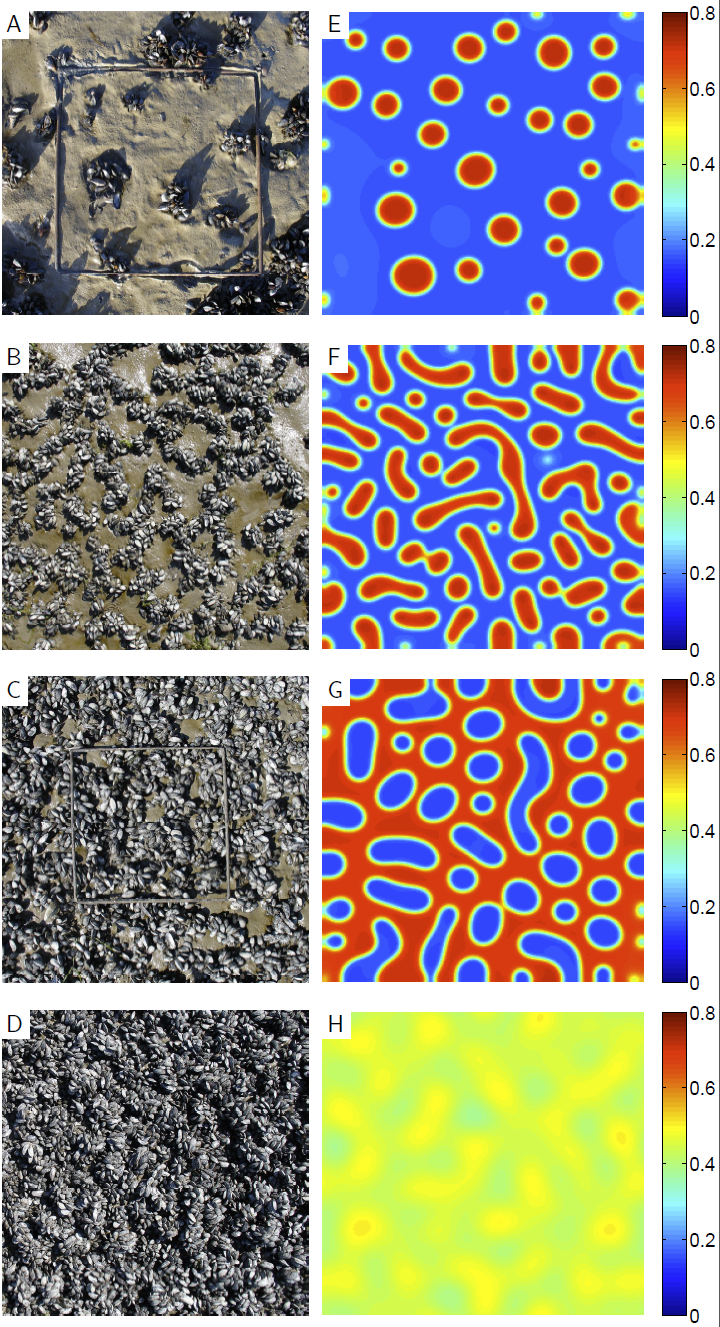SELF-ORGANIZED BEHAVIOR OF MICROORGANISMS AND ECOSYSTEMS GROUP
Our group is interested in the emergent behaviors of the microorganisms and ecosystems that are driven out of equilibrium by an external drive, internal activity or local interactions. We use theory and computation to investigate the rich dynamics of a broad range of systems, from mesoscopic matter to algal suspensions, the individual organisms and biogeomorphology. Our group makes complementary use of bottom-up modeling and top-down phenomenology to highlight the role of physical interactions relative to genetically and biophsically-regulated signaling in controlling the large scale self-organization and the mechanical properties of these complex systems.
ECOSYSTEM FUNCTIONING OF MUSSEL BEDS
Theory predicts that self-organized pattern formation has important implications by affecting vulnerability to disturbances and increasing production. Whether these emergent effects depend on the presumed underlying mechanisms is an often ignored question. Here, we show that two models using very different mechanisms for pattern formation in mussel beds are equally able to explain the observed spatial patterns (Liu et al 2012, Proc. R. Soc. B). Interestingly, they predict a strikingly contrasting effect of these spatial patterns on ecosystem vulnerability and production. This study provides a cautionary warning against predictions of the implications of spatial self-organization, when the underling mechanisms are incompletely understood, and not based on experimental study.
Cover image: Blue mussels (Mytilus edulis), attached by means of their strong byssal threads, living on the top of sediment hummock in the intertidal flats, Wadden sea, The Netherlands. (See Liu et al 2012, Proc. Roy. Soc. B, pages 2744–2753)
Self-organized biogeomorphology and spatial patterns of tidal creeks in the saltmarshes of Chongming island
Emergence fairy-circle patterns in intertidal saltmarshes at Nanhui shoal, Shanghai



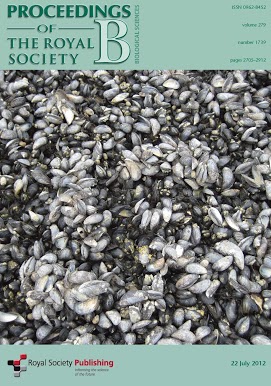

Algal cells aggregate to amazing patterns in lab
Radial/striped patterns in alga cells
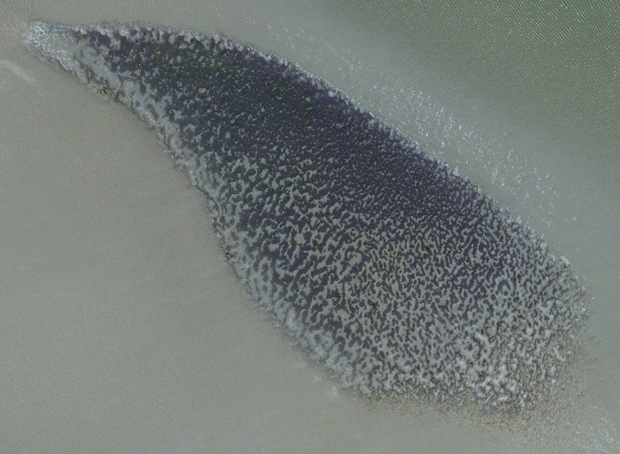
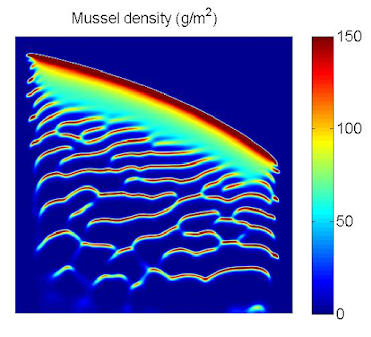
SIMULATION MUSSEL BEDS WITH GPU
Theoretical models highlight that spatial self-organized patterns can have important emergent effects on the functioning of ecosystems, for instance by increasing productivity and affecting the vulnerability to catastrophic shifts. However, most theoretical studies presume idealized homogeneous conditions, which are rarely met in real ecosystems. Using self-organized mussel beds as a case study, we reveal that spatial heterogeneity resulting from the large-scale effects of mussels on their environment, significantly alters the emergent properties predicted by idealized self-organization models that use homogeneous conditions (seeLiu et al 2014, J. Roy. Soc. Interface).
Left image: (bottom) Simulation of intertidal mussel beds using GPU, following the model by Liu et al J.Roy. Soc Interface 2014. Simulation 3D model on mussel beds formation with GPU. (top) The realistic mussel beds on Wadden Sea, The Netherlands.
PHASE SEPARATION PRINCIPLE IN MUSSEL PATTERNING
Using mussels as expriment, we demonstrate that the physical principle of phase separation (which is well-known and widely used in physics, but absent in the ecological literature) is able to explain spatial pattern formation in ecological systems (Liu et al, 2013 PNAS). Specifically, we show that aggregation of mussels into labyrinth-like patterns closely follows the mathematical principle for phase separation as outlined by Cahn and Hilliard in 1958.
Until now, the general model used for explaining the underlying regular, self-organized spatial patterns in ecology has been Turing's activator-inhibitor principle, with birth and death processes as the driving ecological process of pattern formation. The phase separation principle, as identified in our work, is solely based on movement and therefore has a behavioral basis. Hence, our study identifies a new, fundamentally different process underlying ecological pattern formation.
Left image: Young blue mussels, Mytilus edulis, formatted amazing self-organized patterns from homogenous spreading larvae, living on the top of soft-sediment in the intertidal flats. (Photos coming from PNAS, 2013, vol.110 p11905-11910)
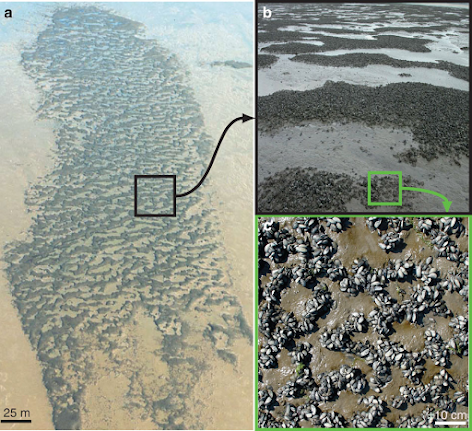
MULTIPLE-SCALE PATTERNS IN ECOSYSTEMS
Many ecosystems display complex spatial patterning at multiple spatial scales, particularly on mussel beds, seagrass, and coral reefs ecosystems. Using a theoretical model, we reveal the underlying mechanisms of the nested patterns development in mussel beds (Nature Communications, 2014 (5) 5234, doi: 10.1038/ncomms6234).
Our novel model analysis reveals that the interaction between these behavioural and ecosystem-level mechanisms increases mussel bed resilience, enables persistence under deteriorating conditions and makes them less prone to catastrophic collapse. Our analysis highlights that interactions between different forms of self-organization at multiple spatial scales may enhance the intrinsic ability of ecosystems to withstand both natural and human-induced disturbances.
Image: (top) Model simulation of the multiple scales self-organization patterns on mussel beds, based on theoretical model (Nature Communications, 2014 (5) 5234) with GPU accelerated computing. (bottom) The theoretical model integrated with dispersion behavior and competition processes on mussels.
